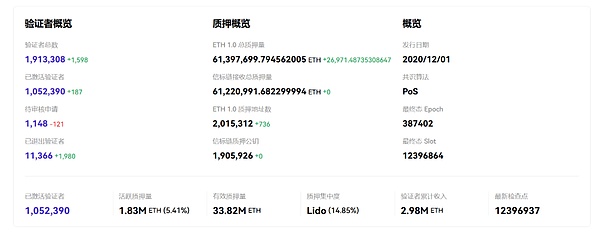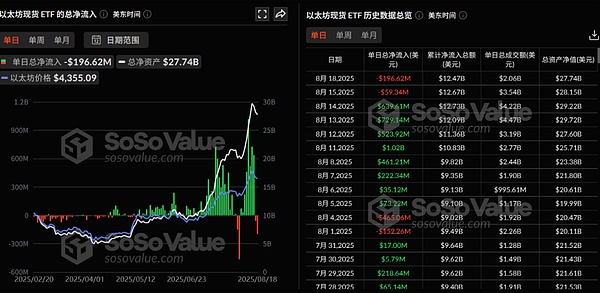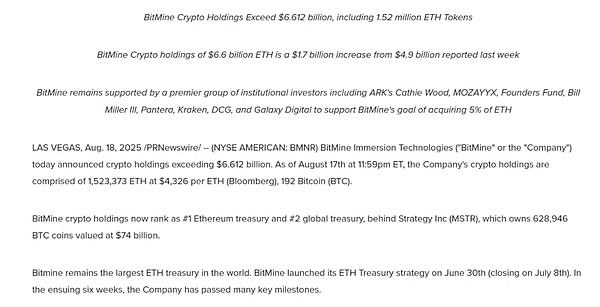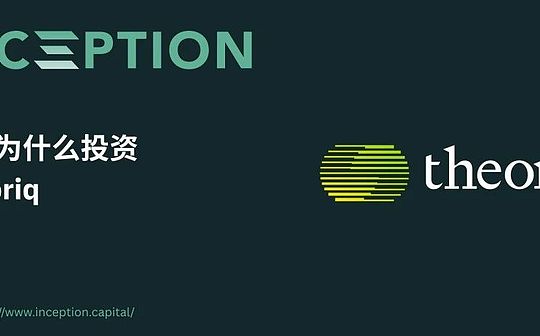
Ethereum is standing at an unprecedented “multiple narrative resonance” node.
At the chain level, the scale of ETH pledge continues to rise, gradually establishing a “risk-free interest rate anchor”; at the traditional financial level, spot ETFs have been operating for more than a year, and trading volume and net inflows are increasing rapidly, marking the continuous increase in compliant funds; at the corporate level, more and more listed U.S. stock companies choose to strategically include ETH in their treasury reserves.
Pledge, ETF and company treasury, these three seemingly independent contexts are echoing each other, jointly promoting ETH to move from a single crypto to a comprehensive financial asset with income attributes, compliance channels and corporate reserve value.
If the story of Bitcoin is “digital gold”, then the narrative of Ethereum is quietly turning to “global ledgers” and ushering in a critical “resonance moment” in 2025.
Pledges are rising steadily, ETH’s “benchmark interest rate” emerges
From 2Since Shanghai upgraded the opening of the pledge withdrawal function in April 2023, Ethereum has completely solved the hidden danger of damstone exit and released the growth potential of the pledge ecosystem. Since then, the derivatives market based on LSD has expanded rapidly, driving the ETH pledge rate to continue to rise..
As of the time of posting,The pledge volume of ETH has exceeded 33.8 million, accounting for about US$140 billion at the current price, accounting for more than 25% of the total supply, which is significantly higher than the pledge rate of about 10% a few years ago.This not only strengthens network security, but also improves the scarcity of ETH from the supply and demand level.

More importantly, ETH staking is gradually becoming the “interest rate anchor” of on-chain finance.
In the past year, the annualized pledge return rate of 3%-5% has been widely accepted by the market, and has even been regarded as the “on-chain version of Treasury bond yield” by some institutional research reports, forming an implicit contrast relationship with the US Treasury yield curve. This attribute makes ETH no longer just a trading asset, but has the underlying logic of fixed income products.
Of course, there has also been a reverse trend worth paying attention to recently – since July 16, ETH destaking requests have increased sharply, and validator exit requests soared from less than 2,000 to 475,000 on July 22, and the waiting time has also increased from less than one hour to more than 8 days.
According to The Block data, there are currently about 670,000 ETHs (about 3.1 billion US dollars), far exceeding the new pledge demand. The expected processing time is close to 12 days. Among them, the lifting of leveraged pledge cycles, LST deanchoring risks and arbitrage opportunities under the background of rising prices are the main reasons for driving a large number of ETH destaking, so Lido, EthFi and Coinbase are the main sources of exits.

Source: The Block
However, although the wave of pledges has brought about fluctuations in the short term,From a long-term perspective, ETH staking has gradually become the “risk-free interest rate anchor” on the chain.Become one of the underlying financial logics of ETH.
It is worth noting that the US Treasury yield in 2024 has remained in the 4%–5% range for a long time, which made the ETH pledge rate unattractive at one point. However, with the Federal Reserve opening a channel for interest rate cuts in 2025, ETH’s 3%–5% pledge returns are back to competitiveness, and are even regarded as “excess returns” in some risk models.
This means that deeper implicit relationships are being established between ETH’s on-chain interest rates and the global liquidity environment, especially the re-pled agreements such as EigenLayer have absorbed more than 10 billion US dollars of ETH, giving birth to the chain logic of “staking interest rate → re-pled premium → protocol security”.
In other words, ETH is not only an asset itself, but also gradually becomes the underlying collateral of the Web3 financial system.
ETFs become the main channel for traditional funds
In May 2024, the US SEC approved the 19b-4 application for 8 spot Ethereum ETFs and was officially listed and traded on July 23, marking the official opening of the compliance channel between ETH and Wall Street. Ethereum spot ETFs have been operating for more than a year so far.
Objectively speaking, ETFs, as a “compliance portal”, provide traditional institutions with a channel to directly configure ETH and reduce compliance frictions at the financial and audit levels. According to SoSoValue data, as of now,The total net asset value of the U.S. spot ETF has exceeded US$27 billion, accounting for about 5.34% of Ethereum’s market value. Since its listing, the cumulative net inflow has reached US$12.4 billion.
However, the market often overestimates the short-term effects of new things in the early stages and underestimates their long-term influence. The development of ETH spot ETFs is a microcosm of this rule, because the true explosion of ETFs did not appear from the beginning—Until May this year, the average daily trading volume of ETH ETFs was still relatively low and market interest was limited.

Source: SoSoValue
The turning point occurred on August 11, 2025. On that day, the net inflow of Ethereum ETFs exceeded US$1 billion for the first time, of which BlackRock’s ETHA attracted US$640 million in funds, and Fidelity’s FETH attracted US$277 million in funds. The siphon effect of the two giants was highlighted, and the institutional shift of Ethereum ETFs has already emerged.
The significance of ETF is that it is not only a “channel” for funds, but also a “legal title” in compliance audits and financial statements, which greatly reduces the resistance of institutions to hold ETH, and another far-reaching significance is that it opens up the arbitrage and allocation paths for cross-border financial institutions.
More importantly,The concentration of holdings of ETFs has begun to appear. BlackRock and Fidelity two major ETFs account for 2/3 of the US ETH ETF market. This trend of head-to-head not only brings about capital siphon effect, but may also mean that the “institutional pricing” characteristics of ETH will become increasingly obvious in the future.
ETH accelerates its influx into U.S. balance sheet
If MicroStrategy to BTC is a milestone case for listed companies to include crypto assets into their balance sheets, then ETH is also ushering in a similar turning point starting in 2025.
Recently, more and more US stock companies have chosen to include ETH in their treasury, and they are not symbolic, but are allocated on a large scale and strategic basis.
Taking BitMine as an example, according to official disclosure,Its crypto assets have exceeded $6.612 billion, up about $1.7 billion from $4.9 billion in the previous week,Among them, BitMine holds 1.523 million ETH (calculated at the current US$4,326 per piece), and also holds 192 BTC.

Source: BitMine
At the same time, Nasdaq-listed company Cosmos Health also announced a securities purchase agreement with a US institutional investor of up to $300 million to launch the ETH treasury strategy and provide custody and pledge infrastructure through BitGo Trust.
This trend of actively inclusion in the treasury is different from the passive allocation of ETFs: ETFs carry more exposure demand for financial products, and directly purchasing ETH and inclusion in the treasury means that ETH is becoming an actual settlement medium and reserve assets. Whether it is financial diversification, cross-border payments, or employee incentives and R&D incentives, ETH has begun to show the application potential of “current assets”.
Overall, after the last wave of widespread narratives, Ethereum’s multiple narratives are forming a synergy:
-
The pledge income brings interest rate anchors like “treasury bonds” to ETH;
-
ETFs have opened up a channel for allocation of compliant funds;
-
The corporate treasury further gives the true value of ETH reserves and payments;
The three are intertwined to jointly promote ETH from “crypto tokens” to “financial infrastructure assets”.
If Bitcoin represents “digital gold” in the corporate treasury, then the value narrative of Ethereum is gradually pointing to “the liquidity core of global ledgers.”







